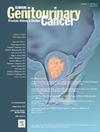Safety and Efficacy of 177Lu-PSMA Therapy Following 223Radium Treatment: A Retrospective Multinational Real-World Analysis
IF 2.7
3区 医学
Q3 ONCOLOGY
引用次数: 0
Abstract
Background
177Lu PSMA therapy is increasingly used for metastatic castration-resistant prostate cancer (mCRPC) treatment. However, data on its efficacy and safety in patients previously treated with 223Ra remain limited.
Methods
This retrospective, multicenter study evaluated 233 mCRPC patients treated with 177Lu PSMA at 5 European centers. The cohort included 27 patients previously treated with 223Ra and 206 Radium-naive patients. Statistical analyses, including Chi-squared, Mann-Whitney U tests, and multivariate logistic regression, were used to assess response and mortality. Predictors of response and mortality were identified using multivariate models.
Results
Patients who experienced a longer interval between castration resistance and the initiation of 177Lu PSMA therapy demonstrated better responses (median 17 months in responders vs. 8.5 months in progressors, P = .001). Platelet counts were significantly lower in the progressive group compared to the responsive group (P = .01). Multivariate regression confirmed lower platelet levels as a predictor of poor response (P = .029). The overall response rate to 177Lu PSMA was 54%, similar between the 223Ra-pretreated and Radium-naive groups. However, mortality was significantly higher in the 223Ra-pretreated group (86%) compared to the Radium-naive group (51%, P = .003). ECOG performance status (P = .004) and ALP levels (P = .030) were significant predictors of mortality, while CRP showed a trend towards significance (P = .064). Tolerability of 177Lu PSMA was comparable to the safety profile reported in the literature, with 44% of 223Ra-pretreated patients experiencing AEs and 22% experiencing severe AEs (Grade ≥ 3).
Conclusions
177Lu PSMA therapy is effective and well-tolerated in mCRPC patients pretreated with 223Ra. However, higher mortality was observed in the 223Ra-pretreated group. ECOG PS, ALP, and platelet counts were significant predictors of response and mortality, and a longer interval between therapies was associated with better outcomes. These findings underscore the importance of treatment sequencing and monitoring prognostic markers.
223Radium 治疗后 177Lu-PSMA 治疗的安全性和有效性:多国真实世界回顾性分析
背景177Lu PSMA疗法越来越多地被用于转移性耐受性前列腺癌(mCRPC)的治疗。这项回顾性多中心研究评估了欧洲 5 个中心接受 177Lu PSMA 治疗的 233 名 mCRPC 患者。研究对象包括 27 名曾接受过 223Ra 治疗的患者和 206 名未接受过镭治疗的患者。统计分析包括Chi-squared、Mann-Whitney U检验和多变量逻辑回归,用于评估反应和死亡率。结果从阉割抵抗到开始接受 177Lu PSMA 治疗之间间隔时间较长的患者的反应较好(反应者的中位数为 17 个月,进展者为 8.5 个月,P = .001)。进展组的血小板计数明显低于应答组(P = .01)。多变量回归证实,较低的血小板水平可预测不良反应(P = .029)。177Lu PSMA 的总体反应率为 54%,223Ra 预处理组和无镭组的反应率相似。然而,223Ra预处理组的死亡率(86%)明显高于无镭组的死亡率(51%,P = .003)。ECOG表现状态(P = .004)和ALP水平(P = .030)是死亡率的重要预测因素,而CRP则有显著性趋势(P = .064)。177Lu PSMA的耐受性与文献报道的安全性相当,223Ra预处理患者中有44%出现AE,22%出现严重AE(≥3级)。然而,223Ra预处理组的死亡率较高。ECOG PS、ALP和血小板计数是预测反应和死亡率的重要指标,治疗间隔时间越长,疗效越好。这些发现强调了治疗排序和监测预后指标的重要性。
本文章由计算机程序翻译,如有差异,请以英文原文为准。
求助全文
约1分钟内获得全文
求助全文
来源期刊

Clinical genitourinary cancer
医学-泌尿学与肾脏学
CiteScore
5.20
自引率
6.20%
发文量
201
审稿时长
54 days
期刊介绍:
Clinical Genitourinary Cancer is a peer-reviewed journal that publishes original articles describing various aspects of clinical and translational research in genitourinary cancers. Clinical Genitourinary Cancer is devoted to articles on detection, diagnosis, prevention, and treatment of genitourinary cancers. The main emphasis is on recent scientific developments in all areas related to genitourinary malignancies. Specific areas of interest include clinical research and mechanistic approaches; drug sensitivity and resistance; gene and antisense therapy; pathology, markers, and prognostic indicators; chemoprevention strategies; multimodality therapy; and integration of various approaches.
 求助内容:
求助内容: 应助结果提醒方式:
应助结果提醒方式:


